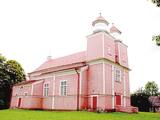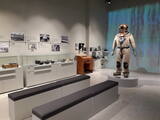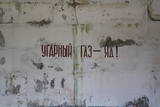| Нo | Название | Описание |
|---|---|---|
|
Находится недалеко от автодороги А 9, к западу от дома Батаров, где 22 марта 1919 года состоялся бой между бригадой генерала Яниса Балодиса и большевиками. Открыт в 1936 году. |
||
|
This is one of the highest points among the hillocks of the Selonian area of Zemgale – Borīškalns Hill. From the tower, you will see Lake Sauka, as well as the forests and farmland which surround it. The “Kalna Ļūdāni” farm is nearby, and its owner uses his livestock to help to maintain the surrounding landscape.
|
||
|
В своих работах воплощает традиционные гончарные традиции. Делает подсвечники и двухрожковые светильники. В ходе творения работ использует даже молоко! Предлагается экскурсия, покупка работ, приглашение на открытие печи. |
||
|
Находится в южной части поселка Феймани. Церковь построена в период времени с 1756-го по 1760-й год. Фреймани были собственностью рода баронов фон Корфов. Церковь принадлежала разным конфессиям в соответствии с изменением вероисповедания Корфов, перейдя из лютеранства в католичество. Стоит упомянуть, что Фейманская католическая церковь выделяется среди церквей Резекненского края наибольшим количеством памятников искусства государственного значения. Среди них стоит отметить исповедальную скамью, скамьи богомольцев, органный проспект, серебряные ковши и пятнадцать, в том числе 18-го века, резных декоров из дерева. Возле входных ворот церкви высится колокольня с четырьмя колоколами. На Страстной неделе вместо колоколов в церкви используют т.н. «колотушки», представляющие собой предметы 2 м длиной и 1 м высотой, напоминающие старинные бельевые катки. В Феймани находится одна из трех мастерских в Латвии по изготовлению знамен, в которой установлено современнейшее оборудование в Балтии. В этом месте как идейно, так и физически «родилось» знамя Латгалии. |
||
|
Viena no augstākajām Latvijas celtnēm ar vienu no augstākajiem skatu laukumiem (65 m). Paveras izcila Vecrīgas un Rīgas ainava, kā arī Daugavas (līdz Rīgas HES dambim) un Pārdaugavas skati. Labi redzami blakus esošie Rīgas centrāltirgus paviljoni. |
||
|
Nacionālā parka galvenā ainavas dominante. Ezers ir ~ 8,4 km garš un līdz 3,3 km plats. Tā austrumu krasti pārsvarā ir ar mežiem apauguši, ziemeļrietumu krasts – purvains, bet rietumu krastā parādās apdzīvotas sētas un simpātiskā Plateļu (Plateliai) pilsētiņa, kur meklējamas skaistākās skatu vietas. Ezera krastos ir labi attīstīta infrastruktūra - tūristu mītnes, ēdināšanas uzņēmumi (Plateļos), ūdenssporta un atpūtas inventāra noma. Ūdens dzidruma dēļ, Plateļu ezeru ir iecienījuši zemūdens niršanas entuziasti. Ezerā ir vairākas salas, no kurām interesanta ir Pils salas (Pilies sala), uz kuras no 15. – 16. gs. atradās muiža. Pastāv uzskats, ka senie Plateļu apkārtnes iedzīvotāji sākotnēji ir dzīvojuši uz salas, kuru ar krastu savienojis uz pāļiem celts tilts. Jāpiemin, ka 15 gs. pirmoreiz pieminētā Plateļu pilsētiņa atradusies uz Šventorkalņa (Šventorkalnis) kalna. Apkārt Plateļu ezeram ir izveidots ~ 24 km garš velomaršruts. Tā ir ļoti laba iespēja iepazīt parku videi un ceļotāja veselībai draudzīgā veidā. |
||
|
This exhibition features the Pļaviņas hydroelectric power plant as a unique architectural building with unique engineering elements. It is the largest producer of electricity in the Baltic States and one of the largest in
|
||
|
Предлагается рыбалка на озере Усмас. Из улова хозяйка готовит вкусную уху и коптит рыбу. Лодка напрокат, рыбалка, вытягивание сети (даже зимой), катание на катере по озеру. Дегустации консервов, сделанных из копченого леща. Верховая езда. |
||
|
Хозяева восстановили хлебную печь, используемую в четвертом поколении, чтобы продолжить традицию выпечки хлеба. Семья печет хлеб в осенние и зимние месяцы – с сентября по апрель. На мероприятиях, организуемых Приморским музеем Вентспилса, можно попробовать традиционные латышские блюда, соответствующие времени года. |
||
|
Начиная с 2007 года, каждый интересующийся может осмотреть производство фарфора, экспозицию с фарфоровыми изделиями, приобрести сувениры или сделать индивидуальный заказ. Для детей особую радость доставляют занятия в студии по росписи фарфора, которая находится здесь же недалеко, в бывшем дворце господской усадьбы «Вецпиебалгас». |
||
|
Ботанический сад является подразделением Шяуляйского университета. Это самый молодой и самый небольшой по площади ботанический сад в Литве. Сад был заложен в 1958 г. Его общая площадь составляет 6,54 га. |
||
|
Дивизион Сталдзенской зенитноракетной бригады занимал обширную территорию с масштабным с точки зрения количества и величины комплексом зданий. Часть из строений находится в частном ведении, обустроена коптильня для рыбы.
|
||
|
Atpūtas vieta Braslas upes krastā, kurā pieejamas telts un kemperu vietas. Tiek piedāvātas dažādas izklaides iespējas: laivu noma, meža futbols un meža biljards. Piedāvājumā arī grila noma un malka ugunskuram. Sadarbībā ar kafejnīcu "Zem ozola" tiek nodrošināta ēdināšana, iepriekš par to vienojoties. |
||
|
In terms of territory, it is the most impressive dune range in the Baltics. This is the only place in the Baltics, where one can enjoy open dune sands that are still active and, under the influence of wind, form the so-called eolian relief forms. There are trails, wooded trails and a paved bikeway for the conveniences of visitors. In order to protect the dune, The Dunes of Curonian spit National Park has been established . |
||
|
Находится в центре Елгавы у моста через Дриксу, которую опоясывает построенная набережная - променад. В интерьере использованы деревянные элементы. Регулярно проводятся музыкальные вечера. Латышская кухня: Холодный суп, жареное филе камбалы или трески, крестьянский завтрак, картофельные и тонкие блины. |
||
|
Один из наиболее красивых садов Ницы, где особенно любимы хосты и клены. Коллекция хостов насчитывает более 130 сортов, а количество кленов уже достигло 25. У большого пруда можно покормить рыбок и насладиться красотой сада. И хозяева, и гости в восторге от впечатляющей вывески дома, появившейся после долгих поисков. Сад добился успехов на конкурсах самых красивых дворов Ницы и Латвии. |
||
|
Хозяин из выращенного в Латвии сырья производит и предлагает более 20 различных (в т.ч. из экзотических цветов) вин. Здесь можно продегустировать и купить вина, сделанные из ягод, плодов, овощей и цветов, в т.ч. из белой сирени, черной бузины, одуванчиков, крупноплодной клюквы и др. В находящемся рядом лилейнике (крупнейшем в Восточной Европе) можно купить рассаду. В саду лилейника можно осмотреть и приобрести сорта всемирно известных селекционеров лилейника, основателя сада В.Баньгиера, а также новые селекционированные сорта лилейника. В общем, в саду можно осмотреть и приобрести более 1000 различных видов лилейника! Сад открыт для свободного посещения в период цветения лилейника в июле - августе, каждый день с 9-19. Предлагают дегустацию домашнего вина "Вейкалниетис". |
||
|
Хозяйство предлагает качественную продукцию местного производства, изготовленную из растений, встречающихся в природном парке Долес и выращенных своими руками. Семейное предприятие, на котором уважают и хранят традиции. |
||
|
В фондах музея хранится более 120 000 предметов, экспозиция представляет историю Лиепаи и юга Курземе – начиная с каменного века и вплоть до 19-го века. Посетителям предлагается также экспозиция, посвященная жизни и творчеству скульптора по дереву Микеля Панкока (1894-1983). В других выставочных залах периодически проводятся выставки современного искусства. |
||
|
Это один из 6 маршрутов путешествий в серии «Насладитесь деревней!», который приглашает посетить «Дары села» – хозяйства и предприятия всевозможных видов и отраслей, которые открыты для посетителей и предлагают экскурсии, попробовать, осмотреть и приобрести свои изделия. Там можно увидеть домашних животных, современные сельские хозяйства, мастерские ремесленников, приобрести сельскохозяйственные продукты – хлеб, мед, домашнее вино и пиво, сыр, ягоды, фрукты, рыбу, мясо, овощи, чаи и другие, выращенные в деревне дары. По дороге можно отобедать в сельских корчмах. Примерное время прохождения маршрута: три - четыре дней, в зависимости от количества выбранных достопримечательностей и времени, отведенного для их осмотра. |
||




























